Envision Math Grade 8 Volume 1 Chapter 6 Congruence And Similarity
Page 325 Exercise 1 Answer
Notice that each block is 1 unit long and 1 unit wide so they are all congruent.

To fit the blue piece into the space provided, rotate it 180∘ counter-clockwise.
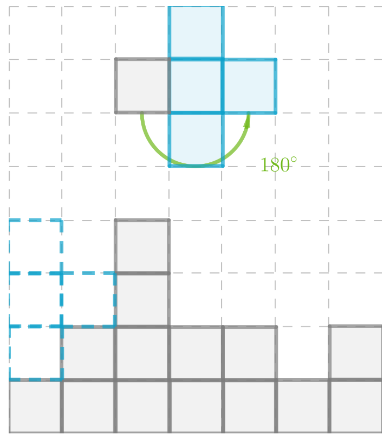
Then, shift the blue piece 3 units to the left.

Lastly, shift the blue piece 4 units down.
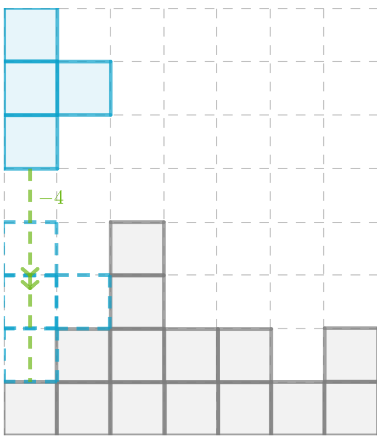
The blue piece fitting on the provided space is shown in the figure.
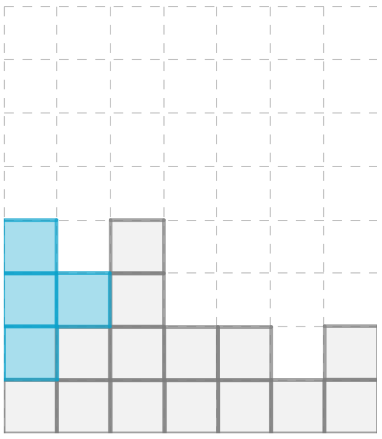
Since each block is 1 unit long and 1 unit wide, it follows that they are all congruent. By rotating and shifting the position of the original blue piece, it can fit into the space as shown.
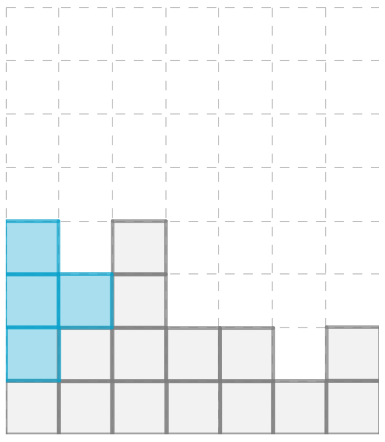

Page 325 Exercise 2 Answer
The piece should be rotated at 180∘.
Then the piece should be translated 3 units right.
Then the piece should be translated 4 units down.
So, the knowledge of translation and rotation can be used to fit the piece in the space.
The piece should be rotated at 180∘, then translated 3 units right and then translated 4 units left.
Envision Math Grade 8 Volume 1 Student Edition Solutions Chapter 6 Congruence And Similarity Exercise 6.5 Page 325 Essential Question Answer
The transformations that always produce congruent figures are TRANSLATIONS, REFLECTIONS, and ROTATIONS. These transformations are isometric, thus, the figures produced are always congruent to the original figures. The transformation that sometimes produce congruent figures is dilation.
Rotations, reflections, and translations are isometric.
That means that these transformations do not change the size of the figure. If the size and shape of the figure is not changed, then the figures are congruent.
A reflection followed by translation, a translation followed by rotation, and a rotation followed by reflection all preserve congruence.
A reflection followed by translation, a translation followed by rotation, and a rotation followed by reflection all preserve congruence.
Page 346 Exercise 3 Answer
If the sequence of translations, reflections and rotations maps one rug onto the other then the rugs are the same size and shape.
Ava uses translation followed by a rotation to map the living room rug onto the hearth rug.
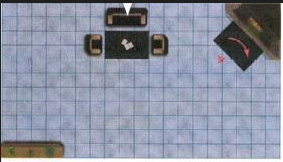
Since the two rugs are the same size and the same shape, they are congruent figures
Page 326 Exercise 4 Answer
A sequence of translations, reflections, and rotations map one rug onto the other then the rugs are the same size and shape.
Congruent figures have the same size and shape. The two-dimensional figure is congruent ( ≃ ) if the second figure can be obtained from the first by a sequence of rotations, reflections, and translations.
Ava uses a translation followed by a rotation to map the living room rug onto the hearth rug.
Since the two rugs are the same size and the same shape, they are congruent figures.
The two rugs are the same size and the same shape, they are congruent figures.
Page 326 Try It Answer
Given:
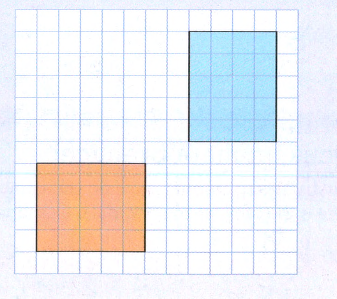
To find: whether the orange and blue rectangles are congruent.
They are both rectangles, thus their corresponding angles are congruent. Their side length need to be checked, if they are congruent, if they do not they are not, by the definition of congruence. Their side lengths need to be checked, if they have the same side lengths they are congruent, if they do not they are not.
Hence, Their side lengths need to be checked, if they have the same side lengths they are congruent, if they do not they are not.
Page 326 Convience Me Answer
Given quadrilateral diagram in graph.
To find the quadrilateral PQRS is congruent to P′Q′R′S′
From the definition of Congruent Polygon,
\(\overline{P Q} \cong P^{\prime} Q^{\prime}, \overline{Q R} \cong Q^{\prime} R^{\prime}\) \(\overline{R S} \cong R^{\bar{\top}} S^{\prime}, \overline{S P} \cong S^{\bar{\prime} P^{\prime}}\) \(\angle P \cong \angle P^{\prime}, \angle Q \cong \angle Q^{\prime}\) \(\angle R \cong \angle R^{\prime}, \angle S \cong \angle S^{\prime}\)Hence, the definition of Congruent Polygons
\(\overline{P Q} \cong P^{\prime} Q^{\prime}, \overline{Q R} \cong Q^{\prime} R^{\prime}\) \(\overline{R S} \cong R^{\bar{\top}} S^{\prime}, \overline{S P} \cong S^{\bar{\prime} P^{\prime}}\) \(\angle P \cong \angle P^{\prime}, \angle Q \cong \angle Q^{\prime}\) \(\angle R \cong \angle R^{\prime}, \angle S \cong \angle S^{\prime}\)
Page 327 Try It Answer
Given figures in a graph
To find the given figures are congruent or not.
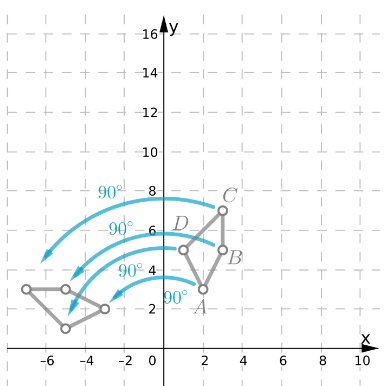
Rotate each vertex of the first figure 90∘
counterclockwise around the origin. Since the quadrilateral A′′B′′C′′D′′ maps onto the second figure, those figures are congruent.
Hence, the first rotated 90∘ counterclockwise around the origin and then translated 13 units to the right maps onto the second figure, so those figures are congruent.
Page 328 Exercise 1 Answer
Given: Sequence of translations, reflections and rotations
To find: The sequence of translations, reflections, and rotations result in congruent figures
Rotations, reflections and translations are isometric. That means that these transformations do not change the size of the figure. If the size and shape of the figure is not changed, then the figures are congruent.
Hence, the size and shape of the figure is not changed, then the figures are congruent.
Envision Math Grade 8 Volume 1 Student Edition Solutions Chapter 6 Congruence And Similarity Exercise 6.5 Page 328 Exercise 2 Answer
Given: Sequence of transformations have to include a translation, a reflection, and a rotation.
To find: The sequence of transformations have to include a translation, a reflection, and a rotation to result in congruent figures
A sequence of transformation does not have to include any of the given transformation to result in a congruent figure. An example of this is the following sequence.
A dilation with respect to a point and with a scale factor of 2,a dilation with respect to the same point and with a scale factor of \(\frac{1}{2}\).
Hence, the sequence of transformation does not have to include any of the given transformation to result in a congruent figure.
Page 328 Exercise 3 Answer
Given: A sequence of reflections, rotations, and translations.
To find: The preimage and image not only congruent, but identical in orientation.
There are multiple sequence with this property, one example would be the following sequence.
Reflection over a line, reflection over the same line.
Hence, Reflection over a line, reflection over the same line is an example of The preimage and image not only congruent, but identical in orientation.
Page 328 Exercise 4 Answer
Given: A rectangle with an area of 25 square centimeters is rotated and reflected in the coordinate plane.
To find: The area of the resulting image.
Rotations and reflections don’t change the measures, thus the area is still 25cm2.
Hence, the area of the resulting image is 25cm2.
Page 328 Exercise 5 Answer
Given:
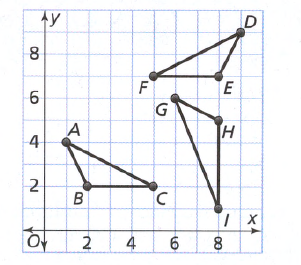
To find: ΔABC≅ΔDEF
We will find the distance between two points and we have to find the given triangle is congruent or not.

Repeat the procedure to determine the length of the sides of both triangle
Therefore, corresponding sides of the triangle are congruent. ΔABC ≅ ΔDEF
Page 328 Exercise 6 Answer
Given:
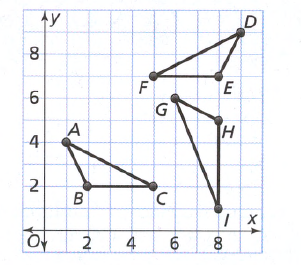
To find ΔABC ≅ ΔGHI
We will find the distance of given triangle and find the given triangle is congruent or not.
For the two triangles to be congruent, the corresponding measures of both triangle must be same.
From figure ΔABC, the length of AC
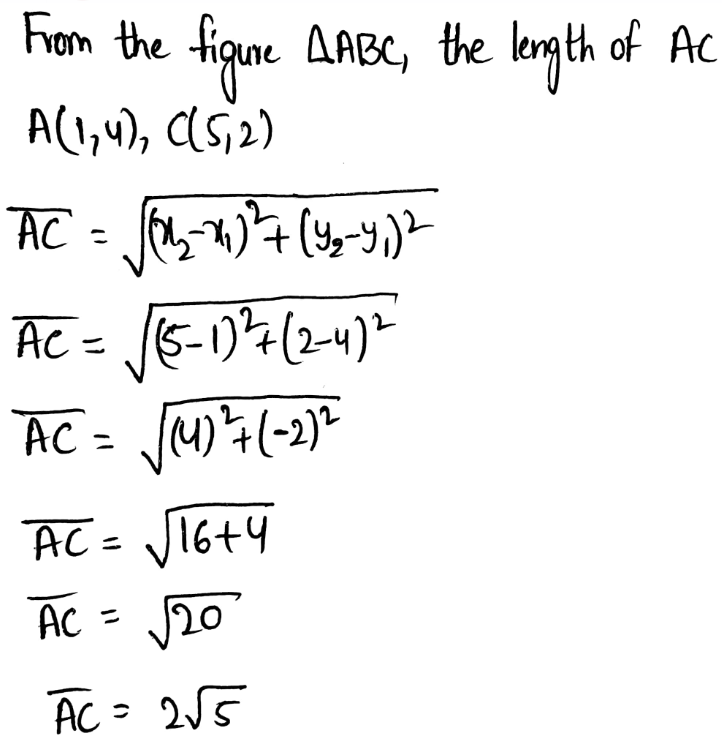
The length of GI in triangle GHI is \(\sqrt{29}\).
Since the corresponding sides are not congruent, the two triangles are not congruent. ΔABC is not congruent to ΔGHI.
Hence, the corresponding sides are not congruent, the two triangles are not congruent.
Page 329 Exercise 7 Answer
As the shape only undergoes reflection and translation. Its shape and size can not change.
Thus, ΔQRS and ΔQ′R′S′ have the same size and shape.
Hence, ΔQRS and ΔQ′R′S′ have the same size and shape.
Page 329 Exercise 8 Answer
Given:
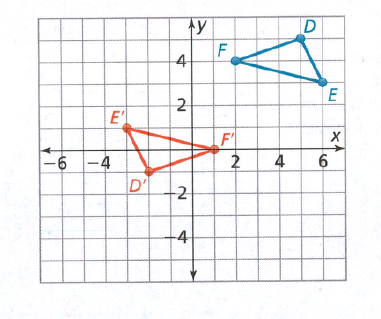
To find the ΔDEF and ΔD′E′F′ is congruent or not.
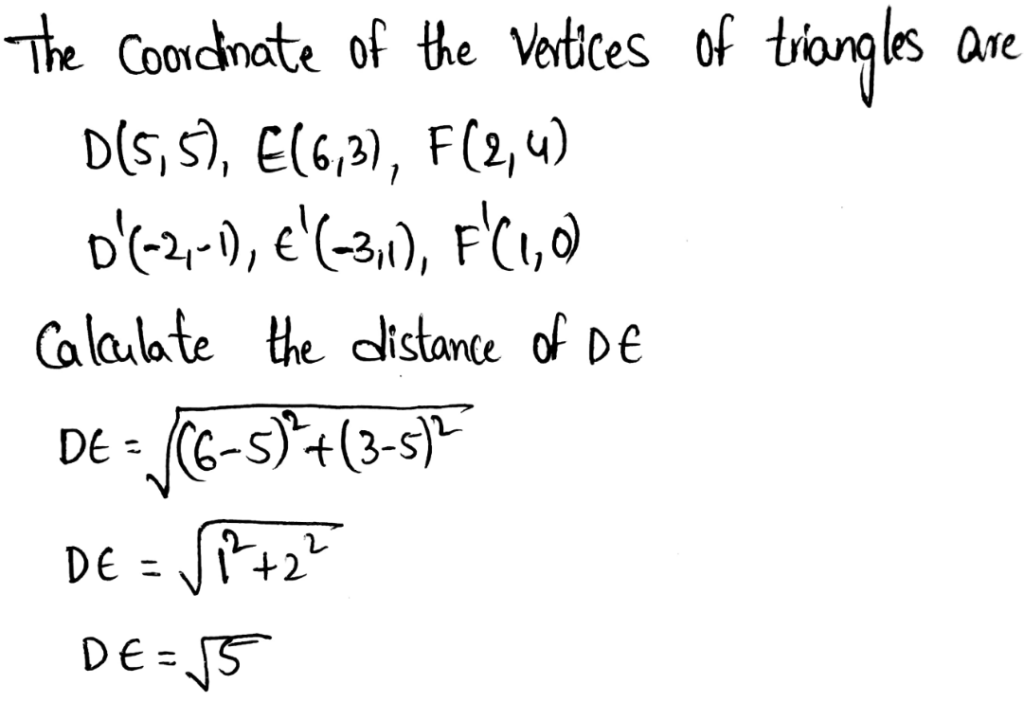
The length of all corresponding sides of both the triangles are equal therefore side-side-side congruence theorem.
ΔDEF Δ D′E′F′
Hence, the length of all corresponding sides of both the triangles are equal therefore side-side congruence theorem
ΔDEF Δ D′E′F′
Page 329 Exercise 9 Answer
Given: Quadrilateral ABCD and A′B′C′D′.
To find the ABCD is congruent to quadrilateral A′B′C′D′
Observe the quadrilateral ABCD
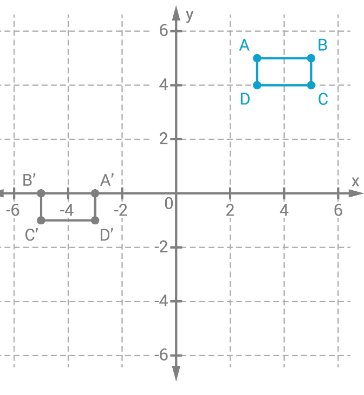
Reflect ABCD over y−axis translate it for 5 units downwards to draw A′B′C′D′. Since both transformation are isometries it follow that A′B′C′D′ is congruent to ABCD.
Hence, A′B′C′D′ is congruent to quadrilateral ABCD.
Envision Math Grade 8 Volume 1 Student Edition Solutions Chapter 6 Congruence And Similarity Exercise 6.5 Page 329 Exercise 10 Answer
Given graph
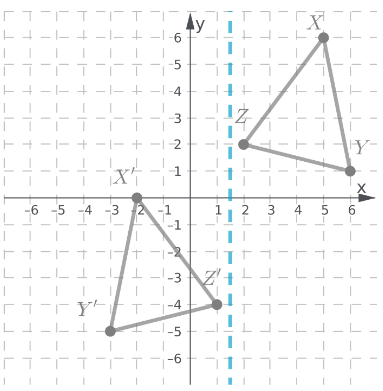
To find the flags the same shape and size.
Construct an line x = 1.5
The flags are the same shape and size because the second flag can be formed by reflecting and translating the first flag.
Hence, the flags are the same shape and size because the second flag can be formed by reflecting and translating the first flag.
Page 330 Exercise 11 Answer
Given:
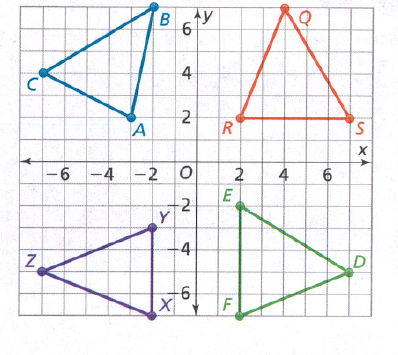
To find which two triangles are congruent.
We will compare the given triangles to find if they are congruent or not.
Plot the points
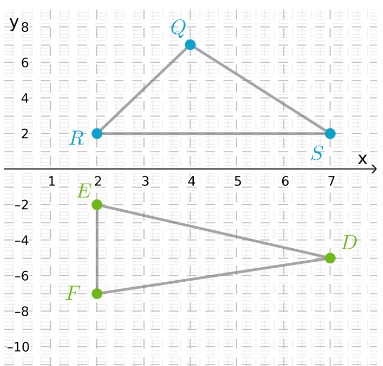
The ΔQRS with coordinates Q(4,7),R(2,2),S(7,2) ΔDEF with coordinates D(7,−5),E(2,−2),F(2,−7)
Next, translate ΔQ′R′S′ 9 units going down.
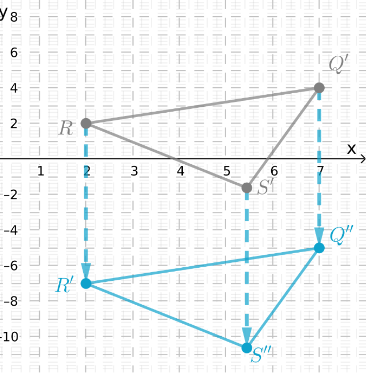
The final image of the ΔQRS is the ΔQ′R′S′ with coordinates Q”(7,−5), R'(2,−7) and S”(2,−2)
Since both have the same vertices ΔQ”R’S”≅ ΔDEF
Therefore, by using the rotation, translation and reflection the ΔQ”R’S” ≅ ΔDEF
Page Exercise 12 Answer
Given points L(7,9),M(9,5)
ΔLMN ≅ ΔXYZ
To find the given triangles are identical or not.
We will calculate the distance between two points LM and also XY and then we will find the given points are identical or not.
As we have already mentioned, congruent figures have the same shape and the same size.
If you look at the triangle LMN,you can notice that these triangle does not have the same size as triangleXYZ.
To be precise, the corresponding size length of triangle LMN are greater then of triangle XYZ.
Therefore, there is no sequence of transformations that maps triangle LMN onto triangle XYZ LMN
We can conclude that these two triangles are not congruent.
ΔLMN ≠ ΔXYZ
Hence, We can conclude that these two triangles are not congruent.
ΔLMN ≠ ΔXYZ
Page 330 Exercise 13 Answer
Plot the points D(4,5),E(5,1),F(1,2)
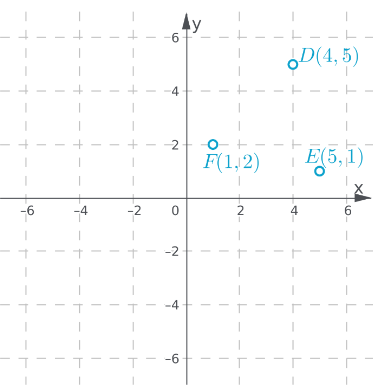
Since the obtained triangle is correct, the initial triangle should have been reflected across the x−axis and translated 6 units left and 4 units up.
The student likely made the mistake of mapping ΔD′E′F′ onto ΔDEF instead of ΔDEF onto ΔD′E′F′.
Therefore, the students made a mistake by translating the triangle 6 units right, as a result of trying to map ΔD′E′F′ onto ΔDEF.
Envision Math Grade 8 Volume 1 Student Edition Solutions Chapter 6 Congruence And Similarity Exercise 6.5 Page 330 Exercise 14 Answer

The triangle , a sequence of rotation maps ΔDEF onto ΔD′E′F′.
Given graph is rotation.
Option (B) is incorrect because the sequence of transformations maps ΔDEF onto ΔD′E′F′
Option(C) is incorrect because the sequence of translations maps ΔDEF onto ΔD′E′F′
Option(D) is incorrect because the sequence of reflections maps ΔDEF onto ΔD′E′F′
Hence, a sequence of rotations maps ΔDEF onto ΔD′E′F′.
Option(A) is correct.
The ΔDEF rotated 180∘ about the point (2,2) and then translated 1 unit to the left maps onto the ΔD′E′F′
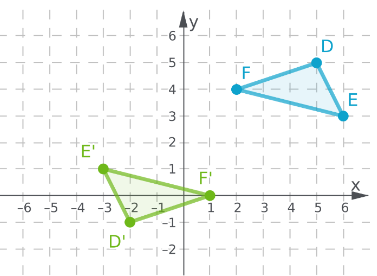
ΔDEF ≅ ΔD′E′F′
Hence proved ΔDEF ≅ ΔD′E′F′, since ΔDEF can be mapped onto ΔD′E′F′ by rotating ΔDEF by 180° about point (2,2) and translating it to the left by 1 unit.
Page 331 Exercise 1 Answer
Rotation:
A rotation is a transformation that turns a figure about a fixed point called the center of rotation. An object and its rotation are the same shape and size, but the figures may be turned in different directions. Rotation may be clockwise or counterclockwise.
Reflection:
In geometry, a reflection is a type of rigid transformation in which the preimage is flipped across a line of reflection to create the image. Each point of the image is the same distance from the line as the preimage is, just on the opposite side of the line.
Translation:
Translation is used in geometry to describe a function that moves an object a certain distance. The object is not altered in any other way. It is not rotated, reflected, or resized. In a translation, every point of the object must be moved in the same direction and for the same distance.
Hence, the three transformations where the image and preimage have the same size and shape are rotation, reflection and translation.
Page 331 Exercise 2 Answer
Given:
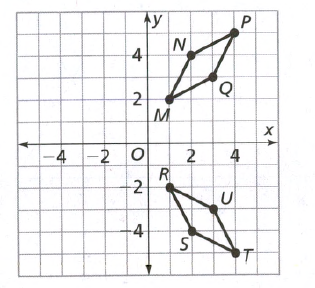
To find: the coordinates of each point after quadrilateral RSTU is rotated 90∘ about the origin.
We know that the coordinates of RSTU then we will rotated 90∘ about the origin R′S′T′U′
Coordinates of RSTU:
R (1,−2)
S (2,−4)
T (4,−5)
U (3,−3)
Rotated 90∘ about the origin:
R′(2,1)
S′(4,2)
T′(4,−5)
U′(3,3)
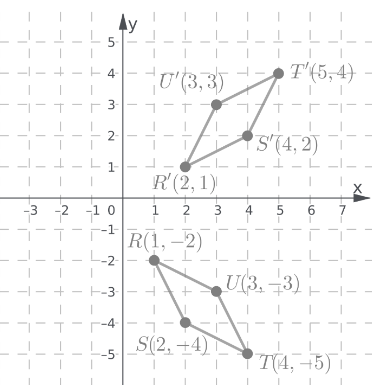
The coordinates of points R(1,−2), S(2,−4), T(4,−5), U(3−3) after a 90∘ rotation about origin are
R′(2,1)
S′(4,2)
T′(5,4)
U′(3,3)
Page 331 Exercise 4 Answer
Given:
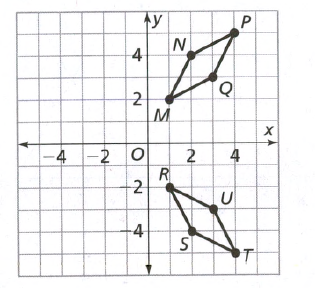
To find the coordinates of each point after quadrilateral MNPQ is reflected across the x−axis.
We know that the coordinates of MNPQ are reflected across the x−axis.
Find the coordinates of the quadrilateral MNPQ from the graph:

Reading from the graph, the vertices are
M(1,2), N(2,4), P(4,5), Q(3,3)
Change the signs of the y-coordinates of the vertices to get the reflected quadrilateral:
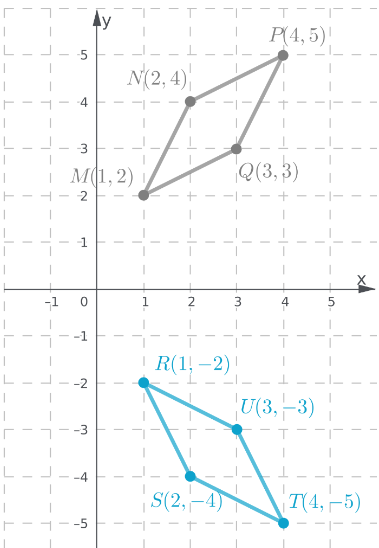
Reading from the graph, the coordinates of the reflected points are R(1,−2),S(2,−4),T(4,−5),U(3,−3)
Hence, the coordinates of the reflected quadrilateral RSTU are (1,−2),(3,−3),(4,−5),(2,−4).
Page 331 Exercise 5 Answer
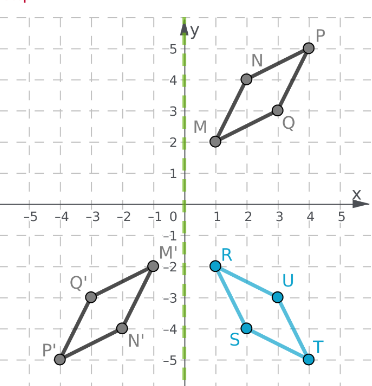
Reflect the rotated figure M′N′P′Q′ across the y−axis.
Rotation 180∘ about the origin, and then reflection across the y−axis.
Option D is correct.
Option(A) is incorrect because reflection across the x−axis, translation 4units down.
Option(B) is incorrect because reflection across the y−axis, translation 4 units down.
Option(C) is incorrect because the rotation 180∘ about the origin, and then reflection across x−axis.
Hence, the rotation 180∘ about the origin, and then reflection across the y−axis.
Envision Math Grade 8 Volume 1 Student Edition Solutions Chapter 6 Congruence And Similarity Exercise 6.5 Page 331 Exercise 6 Answer
Given:

To find the quadrilateral MNPQ congruent to quadrilateral RSTU.
We will find the congruent of given quadrilateral.
Rotate each vertex of the first figure 90°counterclockwise about the origin.

Now if we translate the quadrilateral P′N′M′Q′ 6 units down and 6 units to the right, it maps onto the second figure.
Hence, those figures are congruent.
The first figure rotated 90∘ counterclockwise around the origin and then translated 6 units down and 6 units to the right maps onto the second figure , so those figures are congruent.
